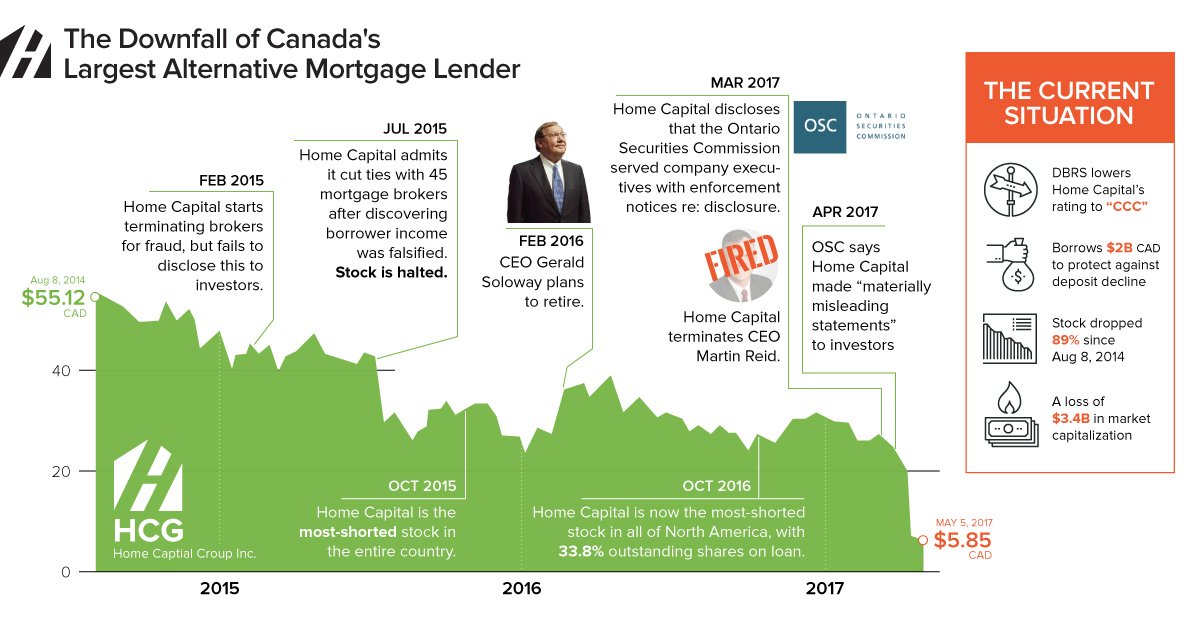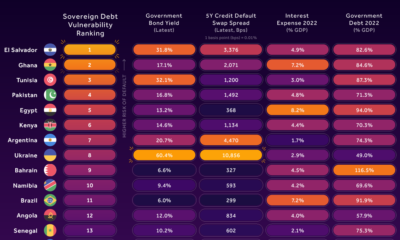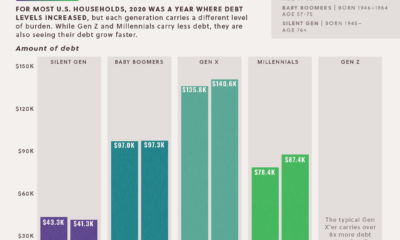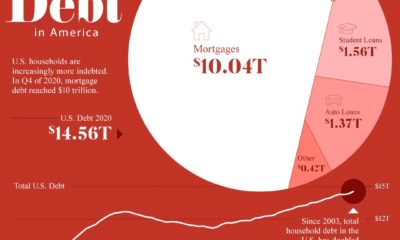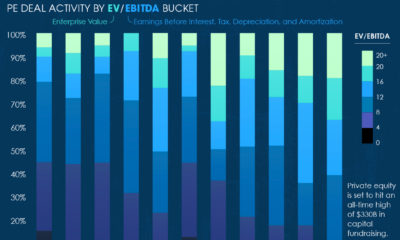If history does indeed rhyme, then the saga of Canada’s largest alternative mortgage lender could be the opening act in a Shakespearean financial tragedy. Home Capital Group, the country’s leader in subprime residential loans, is finally on the ropes after years of speculation. The company was the most-shorted stock in Canada at various points in 2015, and it also took the crown as the most-shorted stock in North America for durations of 2016. Those bears are likely buying the drinks this weekend. Home Capital’s stock has fallen 89% from its peak in August 2014, and over that time the company has shed over $3.4 billion of market capitalization. The biggest portion of the fall came just weeks ago, when depositors withdrew nearly $600 million in cash from Home Capital Group’s balance sheet. In more recent news: the company has also had its credit rating downgraded, opened an emergency credit facility of $2 billion with sky-high interest rates, and shook up its board as part of a “governance renewal”. Oh, and all of this is happening while regulators pursue allegations that the company intentionally misled investors.
Part of a Bigger Narrative
It’s no secret that Canada’s housing and mortgage sector has been precarious for some time. While the country’s banks and real estate sector largely shook off the effects of the Financial Crisis, the market has been bubbly and speculative since then. We previously noted the insanity of Vancouver’s real estate market, and even The Economist was calling Canada the most overvalued housing market in the world years ago. Not much has changed. Governments have tried to step in with foreign buyer taxes, but it’s not enough to stop skyrocketing prices in Toronto. At the same time, Vancouver is also rebounding from recent government interventions to try and cool off the local market. In fact, prices there are up 5% in just three months. While Home Capital Group is a relatively small fish in the Canadian mortgage pond, the saga has also prompted global investors to think deeper about Canadian housing. Are the issues with Home Capital a one-off, or are they systemic to the market as a whole? Is there a possibility of widespread contagion?
Gut Check Time
Markets are divided on the above issues for now. Some analysts are calling Home Capital a speculative buying opportunity, while others see it as a potential trigger for the puncture of the Canadian housing bubble. Contagion has already been spreading, especially to other lenders such as Equitable Group – a company with a similar business model, that has seen shares fall 34% over the last month. Jaeme Gloyn, National Bank (April 27th, 2017) At the same time, house prices continue to increase – and governments are doing everything in their power to cool them off without triggering a recession. It’s a financial tightrope act that will be watched closely by investors around the world. If the Home Capital saga is indeed just the opening act of a Shakespearean financial tragedy, then the following act will also be one to watch. on The good news is that the Federal Reserve, U.S. Treasury, and Federal Deposit Insurance Corporation are taking action to restore confidence and take the appropriate measures to help provide stability in the market. With this in mind, the above infographic from New York Life Investments looks at the factors that impact bonds, how different types of bonds have historically performed across market environments, and the current bond market volatility in a broader context.
Bond Market Returns
Bonds had a historic year in 2022, posting one of the worst returns ever recorded. As interest rates rose at the fastest pace in 40 years, it pushed bond prices lower due to their inverse relationship. In a rare year, bonds dropped 13%.
Source: FactSet, 01/02/2023.
Bond prices are only one part of a bond’s total return—the other looks at the income a bond provides. As interest rates have increased in the last year, it has driven higher bond yields in 2023.
Source: YCharts, 3/20/2023.
With this recent performance in mind, let’s look at some other key factors that impact the bond market.
Factors Impacting Bond Markets
Interest rates play a central role in bond market dynamics. This is because they affect a bond’s price. When rates are rising, existing bonds with lower rates are less valuable and prices decline. When rates are dropping, existing bonds with higher rates are more valuable and their prices rise. In March, the Federal Reserve raised rates 25 basis points to fall within the 4.75%-5.00% range, a level not seen since September 2007. Here are projections for where the federal funds rate is headed in 2023:
Federal Reserve Projection*: 5.1% Economist Projections**: 5.3%
*Based on median estimates in the March summary of quarterly economic projections.**Projections based on March 10-15 Bloomberg economist survey. Together, interest rates and the macroenvironment can have a positive or negative effect on bonds.
Positive
Here are three variables that may affect bond prices in a positive direction:
Lower Inflation: Reduces likelihood of interest rate hikes. Lower Interest Rates: When rates are falling, bond prices are typically higher. Recession: Can prompt a cut in interest rates, boosting bond prices.
Negative
On the other hand, here are variables that may negatively impact bond prices:
Higher Inflation: Can increase the likelihood of the Federal Reserve to raise interest rates. Rising Interest Rates: Interest rate hikes lead bond prices to fall. Weaker Fundamentals: When a bond’s credit risk gets worse, its price can drop. Credit risk indicates the chance of a default, the risk of a bond issuer not making interest payments within a given time period.
Bonds have been impacted by these negative factors since inflation started rising in March 2021.
Fixed Income Opportunities
Below, we show the types of bonds that have had the best performance during rising rates and recessions.
Source: Derek Horstmeyer, George Mason University 12/3/2022. As we can see, U.S. ultrashort bonds performed the best during rising rates. Mortgage bonds outperformed during recessions, averaging 11.4% returns, but with higher volatility. U.S. long-term bonds had 7.7% average returns, the best across all market conditions. In fact, they were also a close second during recessions. When rates are rising, ultrashort bonds allow investors to capture higher rates when they mature, often with lower historical volatility.
A Closer Look at Bond Market Volatility
While bond market volatility has jumped this year, current dislocations may provide investment opportunities. Bond dislocations allow investors to buy at lower prices, factoring in that the fundamental quality of the bond remains strong. With this in mind, here are two areas of the bond market that may provide opportunities for investors:
Investment-Grade Corporate Bonds: Higher credit quality makes them potentially less vulnerable to increasing interest rates. Intermediate Bonds (2-10 Years): Allow investors to lock in higher rates.
Both types of bonds focus on quality and capturing higher yields when faced with challenging market conditions.
Finding the Upside
Much of the volatility seen in the banking sector was due to banks buying bonds during the pandemic—or even earlier—at a time when interest rates were historically low. Since then, rates have climbed considerably. Should rates moderate or stop increasing, this may present better market conditions for bonds. In this way, today’s steep discount in bond markets may present an attractive opportunity for price appreciation. At the same time, investors can potentially lock in strong yields as inflation may subside in the coming years ahead. Learn more about bond investing strategies with New York Life Investments.
